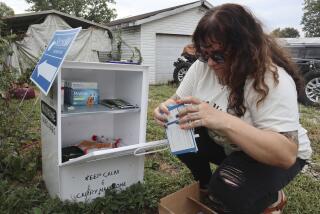Is There Really a Painless Way to Get Off Heroin?
- Share via
MIAMI — After years as a slave to heroin, Craig Einhorn feared that he would never get clean--let alone in a single day.
Even though he was on methadone, he was spending as much as $800 a day on the street to buy more drugs just to keep from getting sick. As his weight ballooned to 265 pounds, his vital signs were heading toward zero.
And then he got busted.
Facing charges of possession with intent to distribute, “I had two choices: jail or death,” said Einhorn, 39, a Miami meat cutter. “I really thought I would never get off heroin. I had tried kicking before, but I always went back. And besides, trying to kick is so painful.”
Indeed, as heroin use creeps up across America, horror stories about the torture of withdrawal are as common as ruined lives. About 70% of all U.S. heroin addicts relapse within six months of traditional treatment methods, according to statistics.
But Einhorn got lucky. In exchange for a guilty plea to the criminal charges he faced, he was sentenced to two years community control and allowed to enroll in a controversial new program at Miami Beach’s Mt. Sinai Medical Center that promises detoxification in one day, pain-free.
Marketed by CITA Americas, the procedure is called Ultra Rapid Opiate Detoxification.
The program is expensive--$6,000 for a 24-hour hospital stay and up to six months of after-care counseling--and no insurer yet covers it.
Although there are reports of significant success in Europe, the technique is largely untested in the United States. Still, in the last six months the procedure has been credited with weaning scores of hard-core addicts from drugs through pilot programs in Miami, New York and Cedars-Sinai Medical Center in Los Angeles.
The National Institute on Drug Addiction has taken no stance on the technique, but an unpublished report prepared for the institute last year concluded that the technique “is currently without ethical, medical, scientific or financial justification.” The institute is, however, funding a study of the technique to be conducted by Dr. Herbert Kleber of the Columbia University College of Physicians and Surgeons.
There are two keys to the procedure: use of the drug naltrexone and detoxification while the patient is under general anesthesia. Naltrexone is a narcotic antagonist that prevents illicit drugs from binding to receptors in the brain without producing any high itself. It is commonly used to treat overdoses and, when injected into a drug user, produces immediate, painful withdrawal symptoms.
Fear of that withdrawal is what keeps many patients on drugs, said Dr. Juan Wender, head of the Los Angeles Cedars-Sinai program. And because of the nausea, vomiting, tremors, sweating, diarrhea and other symptoms associated with it, he said, only about 35% of those who attempt conventional detoxification complete it.
To circumvent this problem, Dr. Juan Jose Legarda of the Center for the Investigation and Treatment of Addiction in Seville, Spain, pioneered a new approach in which addicts are anesthetized for six to eight hours during the naltrexone detoxification process. While they sleep, they are given a cocktail of as many as 25 different drugs to reduce nausea, diarrhea and other symptoms of the process.
“The people are asleep, they don’t perceive [withdrawal] and they don’t remember it,” Wender said.
After detoxification, patients continue to receive naltrexone for six months to reduce craving and minimize the chance of relapse. They also undergo intense counseling in an effort to correct some of the problems that led them to drug abuse in the first place.
Those who were led into addiction by pain from medical problems also receive treatment to find alternative ways to reduce or eliminate that pain.
Wender notes that 100% of patients complete detoxification, nearly three times the rate for addicts who remain awake during the process.
Preliminary results from New York and Miami, he added, indicate that only about 30% of patients suffer a relapse within six months.
“Obviously, we haven’t been doing this in the United States long enough to have good data, but that is about the same success rate as in Europe,” he said.
Against a long history of highly touted “silver bullet” treatments for opiate addiction, there are many who doubt that naltrexone is a miracle cure.
Although naltrexone is approved by the U.S. Food and Drug Administration for use by addicts who have completed detoxification, it has not been approved for heroin detoxification. But physicians are free to use it for any purpose they see fit.
“Naltrexone helps those who take it orally to maintain sobriety, but as a detox agent, I am not convinced it’s all that significant,” said Frank McNeill, nursing director of the Village, a Miami residential drug treatment center.
In fact, McNeill added, pain-free detoxification may be counterproductive by depriving addicts of a memory of the process that could help “to convince them they shouldn’t go back to using.”
Even Dr. Anthony Albanese, co-medical director of Mt. Sinai’s addiction medicine program--where more than 95 patients have undergone the technique thus far--concedes that without reliable data from U.S. clinical trials, the case for naltrexone is anecdotal.
“The big question is, what happens in follow-up?” he said. “Does this treatment work better than any other method?”
*
What doctors do know is that the procedure apparently has worked for about 4,000 heroin users in Europe and Mexico since the method was pioneered by Legarda in 1992. CITA America’s officials say that 73% of those treated abroad remained opiate-free six months later.
“Recovering from heroin addiction is not high-yield,” Albanese said, so any form of treatment that promises to raise the odds of success is worth trying.
“In their permanent memory, addicts have a high that was amazing, and they spend the rest of their life trying to find that high again,” Albanese said. “And they never do. That’s called chasing the dragon. And that’s the compulsion.”
So far, the procedure has been effective for Einhorn, who was treated in December. “I went in there loaded, and I was a little skeptical,” he said. “I thought this was too good to be true. But I have no desire to use [heroin] today, and [through counseling] I have the tools to [combat that desire] if I do.”
The procedure has also worked for San Francisco resident Robin Leland, a 50-year-old printer who was a heroin addict for 15 years. After seeing a television report about naltrexone in November, Leland and his wife flew to Miami.
“I had been trying to put it off because I had tried to kick two or three times, and it was just too painful,” Leland said. “Heroin was not a drug I was in love with, just a drug I was hooked on. I even brought a stash to the hospital.”
Five months after his stay in Miami, Leland reports that he goes to occasional Narcotics Anonymous meetings and, “I am never tempted. . . . Now life is fun.”
Times medical writer Thomas H. Maugh II contributed to this story.
(BEGIN TEXT OF INFOBOX / INFOGRAPHIC)
Reducing Withdrawal Trauma
A new treatment for addicition combines the narcotic antagonist naltrexone with anesthesia to reduce the trauma of detoxification, increasing the likelihood that recovering addicts will stay clean.
How It Works
* Narcotics like heroin and cocaine bind to specific receptors in brain cells to stimulate the pleasureable release of dopamine.
* Naltrexone is a narcotic antagonist. It binds to the narcotic receptors more strongly than either heroin or cocaine, displacing them from the receptors. But it does not produce a high.
More to Read
Sign up for Essential California
The most important California stories and recommendations in your inbox every morning.
You may occasionally receive promotional content from the Los Angeles Times.










